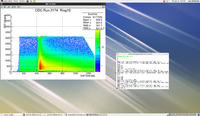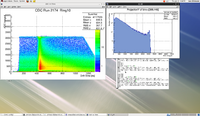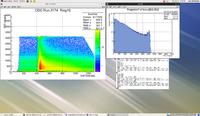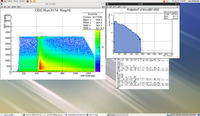Difference between revisions of "Minutes-1-8-2015"
From GlueXWiki
| Line 19: | Line 19: | ||
# FDC update [http://www.jlab.org/Hall-D/detector/fdc/commissioning/Dist2Time_comp.pdf gas difference], [http://www.jlab.org/Hall-D/detector/fdc/commissioning/Sis.ppt gain calibration](Lubomir, Vlad) | # FDC update [http://www.jlab.org/Hall-D/detector/fdc/commissioning/Dist2Time_comp.pdf gas difference], [http://www.jlab.org/Hall-D/detector/fdc/commissioning/Sis.ppt gain calibration](Lubomir, Vlad) | ||
| − | # Other | + | # Electronics |
| + | # Engineering | ||
| + | # Other | ||
| + | |||
<!-- | <!-- | ||
| Line 33: | Line 36: | ||
- Mike was working on a tool to view the signals from the fADC125 modules in a single crate using the built-in pulser. Mike is also working on the CDC efficiency, it's >90% if require the track to be at <1mm to the wire. | - Mike was working on a tool to view the signals from the fADC125 modules in a single crate using the built-in pulser. Mike is also working on the CDC efficiency, it's >90% if require the track to be at <1mm to the wire. | ||
| − | - | + | - Naomi has the test set-up at CMU working again with the prototype straws and old electronics. Waiting for Fernando to get the up-to-date pre-amps/firmware in order to compare with the results in the Hall. |
== FDC update == | == FDC update == | ||
| − | - | + | - Lubomir found the drift velocity of the FDC in the Hall is higher than it was in the EEL126: see the time-to-distance functions plotted above. If it was only Ar/CO2 this suggests that we have now approx. 46/54 gas mixture instead of 40/60 in the EEL, as estimated with Garfield simulations. If this is the case this may partially explain the higher signals seen in the CDC, but certainly not enough to explain the factor of 4 change. It is not clear how one can get 54% CO2 instead of 60%. The gas factor "uncertainty" found by Mike (0.773 actual instead of 0.74 according to the tables) results in 58.5%CO2. At the same time the drift velocity change might be due to adding of alcohol to the gas mixture, which has to be studied with Garfield. |
- Vlad showed plots from the latest runs indicating that we have much more hits per event with the new FCAL&TOF trigger compared with the previous runs with FCAL or BCAL trigger (first plot). Also he showed that for the gain calibration most likely one needs at least 60k hits per plane, the gain coefficient distributions are wider with lower statistics. | - Vlad showed plots from the latest runs indicating that we have much more hits per event with the new FCAL&TOF trigger compared with the previous runs with FCAL or BCAL trigger (first plot). Also he showed that for the gain calibration most likely one needs at least 60k hits per plane, the gain coefficient distributions are wider with lower statistics. | ||
Revision as of 19:09, 9 January 2015
December 18, 2014 FDC+CDC meeting
Connection
- Instructions for Bluejeans meeting connection
- FDC meeting ID: 290664653
- To join via a Web Browser, go to the page [1] https://bluejeans.com/290664653.
Agenda
- CDC update (Mike)
- FDC update gas difference, gain calibration(Lubomir, Vlad)
- Electronics
- Engineering
- Other





